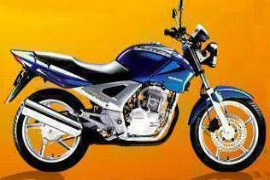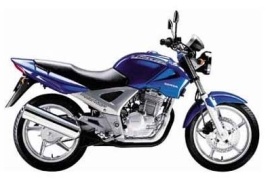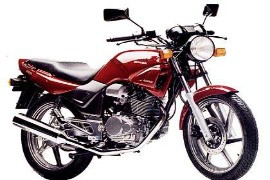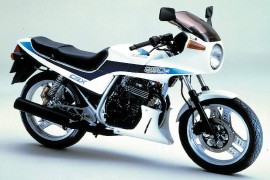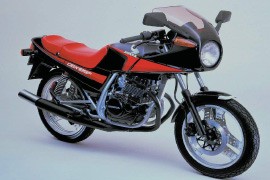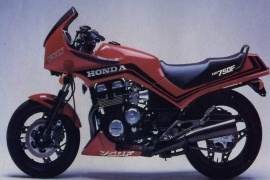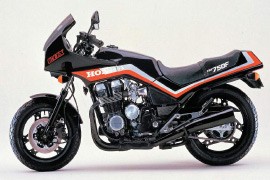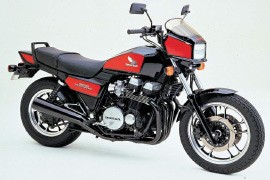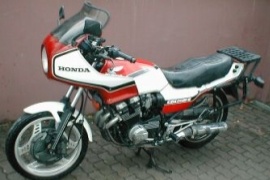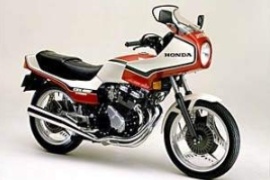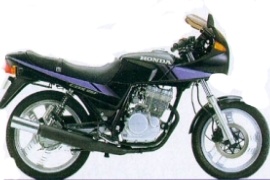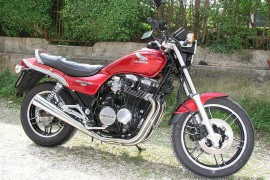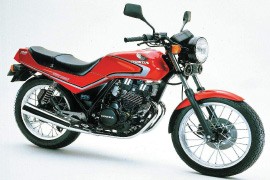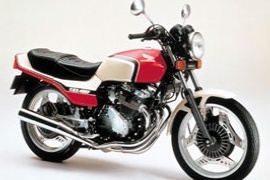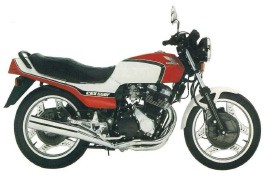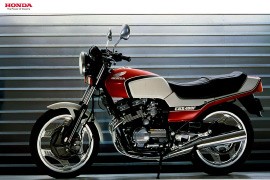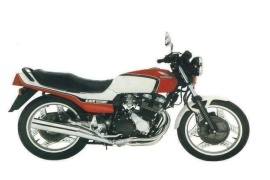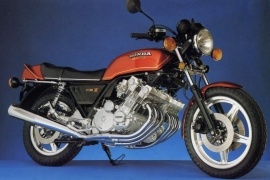HONDA CBX Models/Series Timeline, Specifications & Photos
First production year: 1978
The Honda CBX250 was a half-faired motorcycle with the engine exposed in plain sight, manufactured and sold in Brazil in 2001, and was also known as the Twister in South America.
Also, the CBX250 Twister was sold in Argentina, Mexico, and South Africa and exported to Europe and Australia under the CBF250 name. The bike replaced the CBX200 Strada that ended production in 2002.
The bike came equipped from the factory with standard features, such as a round headlight with a chromed ring, a one-piece dual seat with passenger grab handles, a blacked-out exhaust system with a chromed muffler, twin instrument panels, and cast aluminum wheels.
For suspension, the bike packed a telescopic fork on the front and a single shock absorber on the rear for optimum suspension performance, while the stopping power was generated by a single 276 mm disc squeezed by a two-piston caliper on the front wheel and a 180 mm drum unit on the rear that offered strong braking performance.
As for power, the 2001 Honda CBX250 Twister took its muscles from a 249cc four-stroke single-cylinder air/oil-cooled engine fed by a carburetor and delivered an output power of 24 hp with maximum strength at 8,000 rpm and 24 Nm (18 lb-ft) of torque available at 6,000 rpm.
The Honda CBX250 was a half-faired motorcycle part of the CBX series in Honda's range of motorcycles with the engine exposed for its viewers, manufactured from 2001 until 2015 and also known as the Twister in South America.
The CBX250 Twister was sold in Argentina, Mexico, and South Africa and exported to Europe and Australia under the CBF250 Name. The bike replaced the CBX200 Strada that ended production in 2002.
Over its production years until 2015, the Honda CBX250 Twister carried minor updates, such as graphics and color changes, remaining similar to earlier models. Overall, the CBX250 Twister was a reliable and affordable machine with a compact size, fuel efficiency, and comfortable riding that made it a popular choice among beginner and experienced riders.
In addition, the bike came equipped from the factory with standard features, such as a round headlight with a chromed ring, a one-piece dual seat with passenger grab handles, a blacked-out exhaust system with a chromed muffler, twin instrument panels, and cast aluminum wheels.
As for performance, the Honda CBX250 Twister had at its core a 249cc four-stroke single-cylinder air/oil-cooled engine fed by a carburetor and delivered an output power of 24 hp with maximum strength at 8,000 rpm and 24 Nm (18 lb-ft) of torque available at 6,000 rpm.
The Honda CBX 200 Strada model is a Naked bike, sold from year 1997 and it is equiped with a Single cylinder, two-stroke motor. The engine produces a maximum peak output power of 15.00 HP (10.9 kW) @ 9500 RPM.
The Honda CBX250S was a half-faired motorcycle manufactured by Honda from 1984 to 1998 as a sporty and agile machine, with the engine in plain site and designed to handle both commuting and light touring rides.
For style, the 1986 CBX250S machine packed a sporty look with its fairing, a full set of instrument panels that included a tachometer and a fuel gauge, a comfortable seat, and a rear luggage rack that made the bike suitable for light touring.
The bike came equipped from the factory with standard features, such as a one-piece dual seat, a windscreen, a round headlight integrated into the front cowl, a diamond-shaped steel frame, a blacked-out exhaust system, a black-finished engine with chrome accents, and lightweight cast aluminum wheels.
For suspension, the bike packed a telescopic fork on the front and dual shock absorbers on the rear for optimum suspension performance, while the braking performance was achieved by a 240 mm disc squeezed by a two-piston caliper on the front wheel and a 180 mm drum unit on the rear wheel for optimum stopping power.
As for the power figures, the 1986 Honda CBX250S took its muscles from a 249cc four-stroke single-cylinder air-cooled engine that delivered an output power of 31 hp with maximum strength at 9,500 rpm and 20 Nm (15 lb-ft) of torque available at 9,000 rpm.
The Honda CBX 125F model is a Naked bike manufactured by Honda. In this version sold from year 1984, the dry weight is 105Kg (231.4 pounds) and it is equiped with a In-line four, four-stroke motor. The engine produces a maximum peak output power of 17 HP (12.6 kW) @ 11500.
The CBX750F was a naked machine in Honda's range sold primarily in the Japanese, European, South African, and Australian markets, also known as the CBX750C Horizon, CBX750E, CBX750G, and CBX750P.
The bike was manufactured from 1984 to 1989 and developed from the CB750 in parallel with the VF750 model. Also, it was used by the police forces in Malaysia, Hong Kong, Turkey, Gibraltar, and Ireland under the CBX750P name and was kept in production until 1994.
The police version was based on the CB750SC Horizon, which was like a CB750SCor CB700SC Nighthawk S, but with an 18-inch front wheel and a shaft drive. Compared to the CB700SC, the CBX packed a slipper clutch and diaphragm spring that engaged the clutch.
In the power department, the Honda CBX750F was powered by a 747cc four-stroke four-cylinder air-cooled engine that delivered an output power of 93 hp with a peak at 9,500 rpm and 71 Nm (52 lb-ft) of torque available at 8,500 rpm.
The bike was built around a tubular steel duplex frame that housed a 37 mm air-adjustable fork on the front and a Pro-Link shock absorber with three-way rebound adjustability on the rear that offered optimum suspension performance.
As for braking power, the model featured two 280 mm discs with a couple of two-piston calipers on the front wheel and a 280 mm disc with a two-piston caliper on the rear wheel that provided strong stopping power.
The Honda CBX750F was a naked machine in Honda's range sold primarily in the Japanese, European, South African, and Australian markets, also known as the CBX750C Horizon, CBX750E, CBX750G, and CBX750P.
The bike was manufactured from 1984 to 1989 and developed from the CB750 in parallel with the VF750 model. Also, it was used by the police forces in Malaysia, Hong Kong, Turkey, Gibraltar, and Ireland under the CBX750P name and was kept in production until 1994.
The police version was based on the CB750SC Horizon, which was like a CB750SCor CB700SC Nighthawk S, but with an 18-inch front wheel and a shaft drive. Compared to the CB700SC, the CBX packed a slipper clutch and diaphragm spring that engaged the clutch.
The CBX750F was built around a tubular steel duplex frame that housed a 37 mm air-adjustable fork on the front and a Pro-Link shock absorber with three-way rebound adjustability on the rear that offered optimum suspension performance.
As for braking power, the model featured two 280 mm discs with a couple of two-piston calipers on the front wheel and a 280 mm disc with a two-piston caliper on the rear wheel that provided strong stopping power.
As for the power figures, the 1985 Honda CBX750F had its muscles from a 747cc four-stroke four-cylinder air-cooled engine that delivered an output power of 93 hp with a peak at 9,500 rpm and 71 Nm (52 lb-ft) of torque available at 8,500 rpm.
The Honda CBX750 or RC17, also known as the CBX750C Horizon, was a motorcycle in Honda's range sold primarily in the European, South African, and Australian markets. The bike was manufactured from 1984 to 1988 and developed from the CB750 in parallel with the VF750 model.
Also, the bike was used by the police forces in Malaysia, Hong Kong, Turkey, Gibraltar, and Ireland under the CBX750P name and was kept in production until 1994.
The police version was based on the CB750SC Horizon, which was like a CB750SCor CB700SC Nighthawk S, but with an 18-inch front wheel and a shaft drive. Compared to the CB700SC, the CBX packed a slipper clutch and diaphragm spring that engaged the clutch.
The Honda CBX750C Horizon was one of the forgotten bikes from the 1980s that never quite caught on. The bike packed a four-cylinder DOHC engine with low-maintenance technical details and a semi-upright riding position.
For Suspension, the bike packed a 39 mm air-adjustable telescopic fork on the front and a Pro-Link shock absorber with three-way rebound adjustability on the rear that offered optimum suspension performance.
In the power department, the 1984 Honda CBX750C Horizon had its heartbeat set by a 747cc four-stroke four-cylinder air-cooled engine fitted with four CV-type carburetors that helped deliver an output power of 77 hp with maximum strength at 9,500 rpm and 64 Nm (47 lb-ft) of torque available at 7,000 rpm.
Released in 1983, the CBX 550 F2 sport touring motorcycle came with an air cooled, four stroke, 572cc engine with 60 horsepower at 10000rpm.
The Honda CBX400F was a motorcycle manufactured by Honda from 1981 to 1984. Back in 1981, to address the demand for a motorcycle powered by an inline four-cylinder engine and also brake through the market, Honda introduced the CBX400F bike.
The bike featured a compact body like the one packed by the CB400 Four model, a meter panel similar to that of the CB750F, forged separated handles, forged pedals, an X-shaped four-one-two exhaust system, a hollow aluminum swingarm, a Pro-Link suspension, and ventilated brake discs.
In 1982, the Japanese motorcycle manufacturer introduced the CBX400 Integra, which for the first time in Japan, it featured a front fairing and cancellation mechanism for turn signals. Its CBX550F sister was also introduced, and later in 1983, an American-style CBX400 Custom was added.
In the performance department, the 1983 Honda CBX400F Integra had its muscles from a 399cc four-stroke four-cylinder air-cooled engine fed by four Keihin carburetors and delivered an output power of 48 hp with maximum strength at 10,500 rpm and 33 Nm (24 lb-ft) of torque available at 9,000 rpm.
In the handling department, the bike packed a 35 mm Kayaba fork on the front and a single air shock absorber on the rear, while the stopping power was handled by a 229 mm disc with a hydraulic caliper on the front wheel and a 229 mm disc squeezed by a hydraulic caliper on the rear wheel that provided optimum braking performance.
Kept in production for only one year, the CBX 125F produced by Honda has multiple advanced features such as the electric starting system or the chain final drive.
The Honda CBX650E was a motorcycle built by Honda, primarily designed for the American market, where was designated as the CB650SC Nighthawk and differed by the shape of the fuel tank and the exhaust system that featured slanted mufflers and other handlebar switches.
The bike was a medium-sized CBX motorcycle between the 550 and 750cc displacement and appeared in 1983 with a shaft drive and as a rival to the Yamaha XJ 650 and the Z 550 GT from Kawasaki.
Also, the CBX650E was powered by an air-cooled four-cylinder Otto engine with dual overhead camshafts, 16 valves, hydraulic valve-lash adjustment, and a hydraulically actuated clutch system. It also featured a fuel gauge and a gear indicator, both in LCD technology.
For suspension, the CBX packed a 39 mm Showa air-assisted telescopic fork on the front and dual Showa shock absorbers with five-way spring preload and four-way rebound damping adjustability on the rear end.
In the braking department, the CBX packed two 276 mm discs squeezed by a couple of dual-piston calipers on the front wheel and a drum braking unit on the rear wheel that offered optimum stopping power.
As for power, the Honda CBX650E had at its core a 656cc four-stroke four-cylinder air-cooled engine fed by four Keihin carburetors that helped deliver an output power of 75 hp with maximum strength at 9,500 rpm.
The Honda CBX250RS was a motorcycle sold by Honda in 1983 as a new 250cc sports bike, manufactured to replace the CB250RS. The CBX featured an XR-based engine with particular links to the XR350 bottom end, which included a six-speed manual transmission and the same oil pump.
Also, the stroke was the same, but the bore was reduced to lower the capacity at 249cc, and the balance shaft was removed, locking the engine with rubber mounts. Unlike the XR models, the top of the engine received two camshafts and two carburetors, but only one featured a pilot circuit.
The CBX250RS was sold between 1984 and 1986, along with the CB250RS, at a higher price and not notably better. The sales were not so good, with an estimated 300 units sold, soon replaced by the GB250, which featured a cafe racer style and successfully sold in Japan until 2000 with only minor changes.
The 1983 CBX packed a telescopic fork on the front and two shock absorbers on the rear, while the braking performance was handled by a 240 mm disc with a two-piston caliper on the front wheel and a 180 mm drum braking unit on the rear wheel.
In the power department, the 1983 Honda CBX250RS had its soul brought to life by a 249cc four-stroke single-cylinder air-cooled engine that delivered an output power of 31 hp with maximum strength at 9,500 rpm and 20 Nm (15 lb-ft) of torque available at 9,000 rpm.
In 1982, the Japanese motorcycle manufacturer launched the CBX400F, a motorcycle built between 1981 and 1984, with a compact body like the CB400 Four model, a meter panel like the one used by the CB750F model, forged separated handles, forged pedals, an X-shaped four-one-two exhaust system, hollow aluminum swingarm with a Pro-Link suspension, and ventilated brake discs.
With its sophistication and high performance, the bike had great appeal on the market and featured the highest sales among the sports models in the long run at the time. Also, in 1982, Honda released another model called the CBX400F integra, and for the first time in Japan, it was equipped with a fairing and a cancellation mechanism for turn signals.
For suspension, the bike packed a 35 mm Kayaba fork on the front and a single air shock absorber on the rear, while the stopping power was handled by a 229 mm disc with a hydraulic caliper on the front wheel and a 229 mm disc with a hydraulic caliper on the rear wheel.
In the performance department, the 1982 Honda CBX400F took its muscles from a 399cc four-stroke four-cylinder air-cooled engine fed by four Keihin carburetors that helped deliver an output power of 48 hp with maximum strength at 10,500 rpm and 33 Nm (24 lb-ft) of torque available at 9,000 rpm.
In addition, the bike also came with a chromed exhaust system, a round headlight with a chromed ring, a one-piece seat with two-up capabilities, cast aluminum wheels, a black-finished steel frame, and a center stand.
The Honda CBX550F was a sport-tourer motorcycle part of the CBX series in Honda's range, manufactured from 1982 to 1986. Honda also made available the CBX550F2 model, which was identical to the F model, except for the addition of a half-fairing.
Honda developed a completely new and unusual design for the engine to compete in the middleweight sector that included twin overhead camshafts acting on rockers and screw adjusters for clearance that actuated the four valves per cylinder.
Also, the engine featured a standard oil cooler and a distinctive exhaust system, with cross-over pipes in front of the engine that linked one and four cylinders and a separate pair of pipes that linked two and three cylinders.
For suspension, the bike packed an air-assisted telescopic fork on the front and Pro-Link air-assisted shocks on the rear that offered optimum suspension performance and handling.
In the braking department, the bike featured two 230 mm discs with two-piston calipers enclosed in a drum-type mechanism and a 230 disc with a hydraulic caliper on the rear, also enclosed in a drum-type mechanism.
In the power department, although the 1982 Honda CBX550F had a 550 designation, it was powered by a 572cc four-stroke four-cylinder air-cooled engine fed by four Keihin carburetors that helped deliver an output power of 65 hp with maximum strength at 10,000 rpm and 49 Nm (36 lb-ft) of torque available at 8,000 rpm.
In 1981, the demand for an inline four-cylinder engine motorcycle was pretty high, so Honda decided to address the demand with the introduction of the CBX400F. The CBX400F was a naked motorcycle manufactured by Honda from 1981 to 1984.
The bike featured a compact body like the CB400 Four model, a meter panel like the one used by the CB750F model, forged separated handles, forged pedals, an X-shaped four-one-two exhaust system, hollow aluminum swingarm with a Pro-Link suspension, and ventilated brake discs.
In the long run, the bike, with its sophistication and high performance had a very great appeal on the market and featured the highest sales among the sports models at the time. Also, in 1982, Honda released another model called the CBX400F integra, and for the first time in Japan, it was equipped with a fairing and a cancellation mechanism for turn signals.
For suspension, the bike packed a 35 mm Kayaba fork on the front and a single air shock absorber on the rear, while the stopping power was handled by a 229 mm disc with a hydraulic caliper on the front wheel and a 229 mm disc with a hydraulic caliper on the rear wheel.
In the power department, the 1981 Honda CBX400F had its soul brought to life by a 399cc four-stroke four-cylinder air-cooled engine fed by four Keihin carburetors that helped deliver an output power of 48 hp with maximum strength at 10,500 rpm and 33 Nm (24 lb-ft) of torque available at 9,000 rpm.
The Honda CBX550F was a sport-touring motorcycle manufactured by Honda from 1982 to 1986 and powered by a four-stroke, four-cylinder air-cooled engine. The CBX550F II version was identical to the standard model apart from the additional half fairing.
The model was designated as a 550cc machine, but the actual capacity of the engine was 572cc. Honda designed a new engine with twin overhead camshafts and screw adjusters for valve clearance to compete in the middleweight sector.
The engine was fitted with a standard oil cooler and a unique exhaust system with cross-over pipes in front of the engine, linking one and four cylinders and separate lines for two and three cylinders.
Also, the carburetors were using a new type of mixture-enriching system with fuel passages for cold starts and carefully engineered inlet tracts for smooth gas flow. The bike was known for its ventilated disc brakes with a drum-type enclosure.
The Honda CBX550F's braking system comprised two 230 mm discs with dual-piston calipers on the front and a hydraulic caliper with a 230 mm disc on the rear, offering reliable stopping power.
The bike had a duplex cradle tubular steel frame, an air-assisted telescopic fork, and an anti-dive system on the front. The rear suspension was handled by Pro-Link air-assisted dual shock absorbers.
As for power, the 1982 Honda CBX550F took its force from a 572cc four-stroke four-cylinder air-cooled engine fed by four Kaihin carburetors, delivering an output power of 65 hp at 10,000 rpm and 49 Nm (36 lb-ft) torque at 8,000 rpm.
The Honda CBX was a sports motorcycle part of the CBX series, manufactured from 1978 to 1982. The bike was the flagship of Honda's range and well received by the press but was outsold in late 1979 by its CB900F sibling.
In the mid-1060s, Honda manufactured the RC series six-cylinder race bike, but the CBX model was the first production six-cylinder road bike that featured the GP racing technology.
In 1982, the Japanese motorcycle manufacturer repositioned the CBX into the spot touring section with the CBX-B model that packed a detuned engine to 98 hp and the addition of a Pro-Link monoshock absorber on the rear, a 39 mm air-adjustable front fork, a stronger frame, and a fairing with optional panniers.
The 1978 model packed an air-assisted fork on the front with 160 mm of wheel travel and dual shock absorbers with 100 mm of wheel travel for optimum suspension performance.
In the braking department, the bike featured two 276 mm discs with hydraulic calipers on the front and a single 296 mm disc squeezed by a hydraulic caliper on the rear wheel that offered optimum suspension performance.
In the performance department, the 1978 Honda CBX1000 had its soul brought to life by a 1047cc four-stroke six-cylinder air-cooled engine fed by six Keihin carburetors that helped deliver an output power of 105 hp at 9,000 rpm and 72 Nm (52 lb-ft) of torque available at 6,500 rpm.
